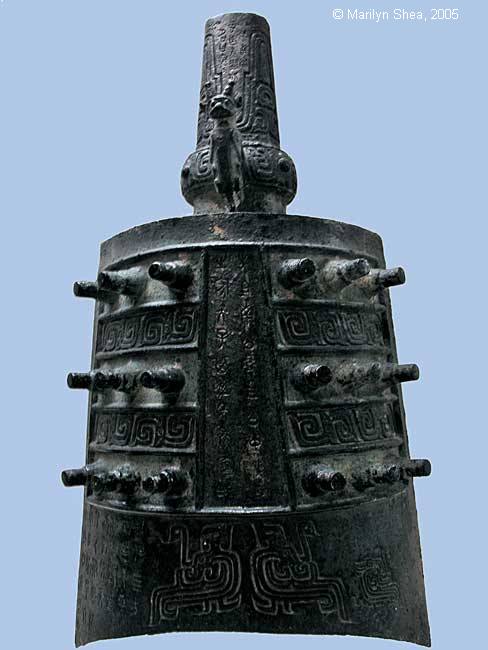 |
| The Nangonghu bell is 21.65 inches tall (55 centimeters) and weighs 62.83 pounds (28.5 kilograms). This type of bell is struck with a padded stick, a plain stick, or a ,etal rod, depending on the sound desired. It is not rung but is chimed. The bells are hung in a series, each bell will have a different tone. Some of the most valuable bells are in sets where all the bells are the same size, but hey still have the tonal characteristics of the full musical scale.
Most of the bell sets are graduated in size. Using this technique makes it much easier to produce the tonal scale. I would imagine that it is easier to learn to play them, as well. Music was an important part of religious and government ceremonies, in fact, a part of most gatherings. Special music accompanied various functions and rituals. Just as we play the "Wedding March" to mark an occasion, the Chinese had certain songs that went with just about everything that you can think of; sacrifices, births, deaths, Spring Festival, retirement, promotions, and things like the sighting of the first bird in spring. Big and small occasions were marked by music. The bell is engraved with 68 Chinese characters that tell us that Nangonghu made the bells to honor ancestors and to pray for longevity. He dedicated the set of bells to the ancestors of all and intended the bells to be used in the worship rituals at the major holidays such as the Spring Festival and Qingming. He described this set of bells as one of several sets of bells that form a group of bells or chimes. You can see a complete set of bells at the Forbidden City Palace Museum HERE. This bell was excavated in 1979 at Baozigou Village, Fufengnanyang County, Baoji, Shaanxi. |
http://hua.umf.maine.edu/China/xian2.html
Last
update: March 2010
© Marilyn Shea, 2010